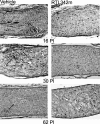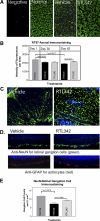Neuroprotective effects of recombinant T-cell receptor ligand in autoimmune optic neuritis in HLA-DR2 mice
- PMID: 22167100
- PMCID: PMC3292374
- DOI: 10.1167/iovs.11-8419
Neuroprotective effects of recombinant T-cell receptor ligand in autoimmune optic neuritis in HLA-DR2 mice
Abstract
Purpose: Optic neuritis (ON) is a condition involving primary inflammation, demyelination, and axonal injury in the optic nerve and leads to apoptotic retinal ganglion cell (RGC) death, which contributes to the persistence of visual loss. Currently, ON has no effective treatment. The goal was to determine the effectiveness of immunotherapy with recombinant T-cell receptor ligand (RTL) in preventing ON in humanized HLA-DR2 transgenic mice.
Methods: Experimental autoimmune encephalomyelitis (EAE) was induced with myelin oligodendrocyte glycoprotein in humanized HLA-DR2 (DRβ1*1501) transgenic mice. Five consecutive doses of RTL342M were administrated at the onset of ON. The development of autoimmune ON was assessed by histopathology at different time points. The levels of myelin loss, axonal loss, and RGC damage were examined by immunofluorescence.
Results: HLA-DR2 mice developed chronic ON 2 days before EAE characterized by progressive neurodegeneration in both organs. RTL342M significantly suppressed inflammation in the optic nerve and spinal cord and provided protection for at least 30 days. Examination of myelin loss showed a marked suppression of demyelination and an increase in myelin recovery in the optic nerve. Moreover, RTL342M treatment revealed a neuroprotective effect on optic nerve axons and RGCs in retinas at postimmunization (PI) day 62.
Conclusions: RTL342M suppressed clinical and histologic signs of EAE/ON by preventing the recruitment of inflammatory cells into the optic nerve and showed neuroprotective effects against ON. However, to achieve full therapeutic benefit, more doses may be needed. These findings suggest a possible clinical application of this novel class of T-cell-tolerizing drugs for patients with optic neuritis.
Figures






Similar articles
-
Loss of Nrf2 exacerbates the visual deficits and optic neuritis elicited by experimental autoimmune encephalomyelitis.Mol Vis. 2016 Dec 30;22:1503-1513. eCollection 2016. Mol Vis. 2016. PMID: 28050123 Free PMC article.
-
Inflammatory demyelination induces axonal injury and retinal ganglion cell apoptosis in experimental optic neuritis.Exp Eye Res. 2008 Sep;87(3):208-13. doi: 10.1016/j.exer.2008.05.017. Epub 2008 Jun 3. Exp Eye Res. 2008. PMID: 18653182 Free PMC article.
-
Recombinant TCR ligand induces tolerance to myelin oligodendrocyte glycoprotein 35-55 peptide and reverses clinical and histological signs of chronic experimental autoimmune encephalomyelitis in HLA-DR2 transgenic mice.J Immunol. 2003 Jul 1;171(1):127-33. doi: 10.4049/jimmunol.171.1.127. J Immunol. 2003. PMID: 12816990
-
MOG35 - 55-induced EAE model of optic nerve inflammation compared to MS, MOGAD and NMOSD related subtypes of human optic neuritis.J Neuroinflammation. 2025 Apr 7;22(1):102. doi: 10.1186/s12974-025-03424-4. J Neuroinflammation. 2025. PMID: 40197321 Free PMC article. Review.
-
Recombinant T cell receptor ligands: immunomodulatory, neuroprotective and neuroregenerative effects suggest application as therapy for multiple sclerosis.Rev Neurosci. 2008;19(4-5):327-39. doi: 10.1515/revneuro.2008.19.4-5.327. Rev Neurosci. 2008. PMID: 19145988 Free PMC article. Review.
Cited by
-
Systemic immunotherapy delays photoreceptor cell loss and prevents vascular pathology in Royal College of Surgeons rats.Mol Vis. 2012;18:2323-37. Epub 2012 Sep 6. Mol Vis. 2012. PMID: 22977300 Free PMC article.
-
Adherent Intestinal Cells From Atlantic Salmon Show Phagocytic Ability and Express Macrophage-Specific Genes.Front Cell Dev Biol. 2020 Oct 15;8:580848. doi: 10.3389/fcell.2020.580848. eCollection 2020. Front Cell Dev Biol. 2020. PMID: 33178695 Free PMC article.
-
Critical Role of Monocyte Recruitment in Optic Nerve Damage Induced by Experimental Optic Neuritis.Mol Neurobiol. 2019 Nov;56(11):7458-7472. doi: 10.1007/s12035-019-1608-0. Epub 2019 May 1. Mol Neurobiol. 2019. PMID: 31044366
-
Inflammatory demyelination induces glia alterations and ganglion cell loss in the retina of an experimental autoimmune encephalomyelitis model.J Neuroinflammation. 2013 Oct 4;10:120. doi: 10.1186/1742-2094-10-120. J Neuroinflammation. 2013. PMID: 24090415 Free PMC article.
-
Transgenic inhibition of astroglial NF-κB protects from optic nerve damage and retinal ganglion cell loss in experimental optic neuritis.J Neuroinflammation. 2012 Sep 10;9:213. doi: 10.1186/1742-2094-9-213. J Neuroinflammation. 2012. PMID: 22963651 Free PMC article.
References
-
- Margalit E, Sadda SR. Retinal and optic nerve diseases. Artif Organs. 2003;27:963–974 - PubMed
-
- Balcer LJ. Clinical practice: optic neuritis. N Engl J Med. 2006;354:1273–1280 - PubMed
-
- Wilejto M, Shroff M, Buncic JR, Kennedy J, Goia C, Banwell B. The clinical features, MRI findings, and outcome of optic neuritis in children. Neurology. 2006;67:258–262 - PubMed
-
- Shams PN, Plant GT. Optic neuritis: a review. Int MS J. 2009;16:82–89 - PubMed
Publication types
MeSH terms
Substances
Grants and funding
LinkOut - more resources
Full Text Sources
Other Literature Sources
Molecular Biology Databases
Research Materials
Miscellaneous

